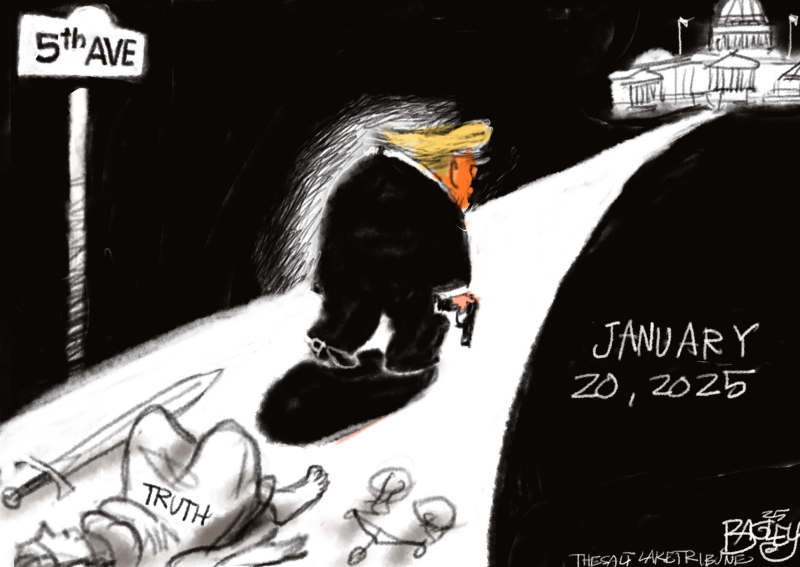Order doesn't protect free speech and indeed might harm it
By Alex
Abdo for Just Security
The actual order, though,
suggests that its goal is to rewrite history to suit its own agenda, and that
it may itself become a vehicle for the new administration to engage in its own
form of jawboning.
The executive order has three main sections. The first, titled “Purpose,” takes aim at the Biden administration’s effort to combat alleged misinformation on social media, characterizing those efforts as a campaign to “suppress speech that the Federal Government did not approve.”
The second section declares that it is the policy of the United States to protect free speech by ensuring that federal officials do not engage in, facilitate, or spend taxpayer money on “any conduct that would unconstitutionally abridge the free speech of any American citizen.”
Third section directs the
Attorney General to “investigate the activities of the Federal Government over
the last 4 years” and to “prepare a report to be submitted to the President …
with recommendations for appropriate remedial actions to be taken.”
If the executive order were limited to the second section,
it would be unobjectionable. That section essentially requires the government
to comply with the First Amendment. While there’s a lot of uncertainty around
the exact limits that the First Amendment imposes on government pressure
related to social media, there’s certainly nothing wrong with reminding federal
officials of their duty to comply with the First Amendment.
But the first and third sections of the order give cause for
concern.
The problem with the first section is that it is a clear effort at revisionist history. Many people criticized the Biden administration for supposedly violating the First Amendment by pressuring the platforms to take down alleged disinformation about Covid and the 2020 elections. (The Knight Institute, where I work, argued in an amicus brief that the Biden administration crossed the constitutional line between persuasion and coercion in one instance.)
When social media users
sued over those allegations, though, the Supreme Court correctly rejected their theory, saying repeatedly
that the evidence of supposed censorship by the government was “weak.” That
case, Murthy v. Missouri, is now back in the lower courts, where
the plaintiffs will get a chance to come up with better evidence supporting
their claims. That’s of course proper—the question of whether the government in
fact coerced the platforms into suppressing protected speech should be decided
on the basis of evidence.
But the first section of the executive order simply
announces the Trump administration’s preferred narrative, seemingly without
regard for what the evidence actually shows.
The first section of the order also focuses narrowly on the supposed censorship of social media by the executive branch, when any sincere effort to root out censorial pressure would be broader. If the administration were genuinely concerned with jawboning, it would also take on the members of Congress who have conducted sham investigations of researchers engaged in constitutionally protected speech.
Recall that, under Rep. Jim Jordan’s (R-OH)
leadership, the House Judiciary Committee sent threatening demands and subpoenas to
researchers around the country to investigate their research into the spread of
disinformation online. Whatever your view on the merits of that research, it is
unquestionably protected by the First Amendment. And so it was incredibly
troubling to see members of Congress abusing their authority in a transparent
attempt to stifle protected speech.
Any sincere effort to confront jawboning would also address
the massive pressure put on universities by Congress to shut down the protests
that took place on their campuses in the aftermath of Oct. 7, 2023.
That leaves the third section, which directs the Attorney General to investigate federal government jawboning and to issue a report. It’s hard to see how this investigation can go forward in good faith.
After all, the
very first section of the executive order seemingly preempts the report by
dictating a position on the very thing that the Attorney General is supposed to
investigate. If it’s not open to the Attorney General to simply disagree with
the first section of the executive order—and to find, as did the Supreme Court,
that evidence of federal coercion is “weak”—then it’s hard to expect anyone to
take the report seriously.
Worse, the report may very well serve as an outlet for the Trump administration’s own censorial desires. If, for example, the report further targets researchers engaged in First Amendment protected research, then the administration will be doing exactly what it has accused the Biden administration of doing.
The charge of hypocrisy hasn’t stopped Jordan’s
committee from harassing researchers, and so we shouldn’t expect it to work
against Trump’s Attorney General, either. But we should at least be clear-eyed about
the motivations that seem to underlie this executive order and that will likely
taint the Attorney General’s investigation.
There’s an alternative version of this executive order that
would have been a genuine victory for free speech. That version of the order
would have directed the government to look at the evidence of jawboning in its
own possession and across multiple contexts, and to follow the evidence where
it leads. Unfortunately, that’s not what we got.
Alex Abdo (Bluesky - LinkedIn - X)
is the Litigation Director of the Knight First Amendment Institute at Columbia
University.
